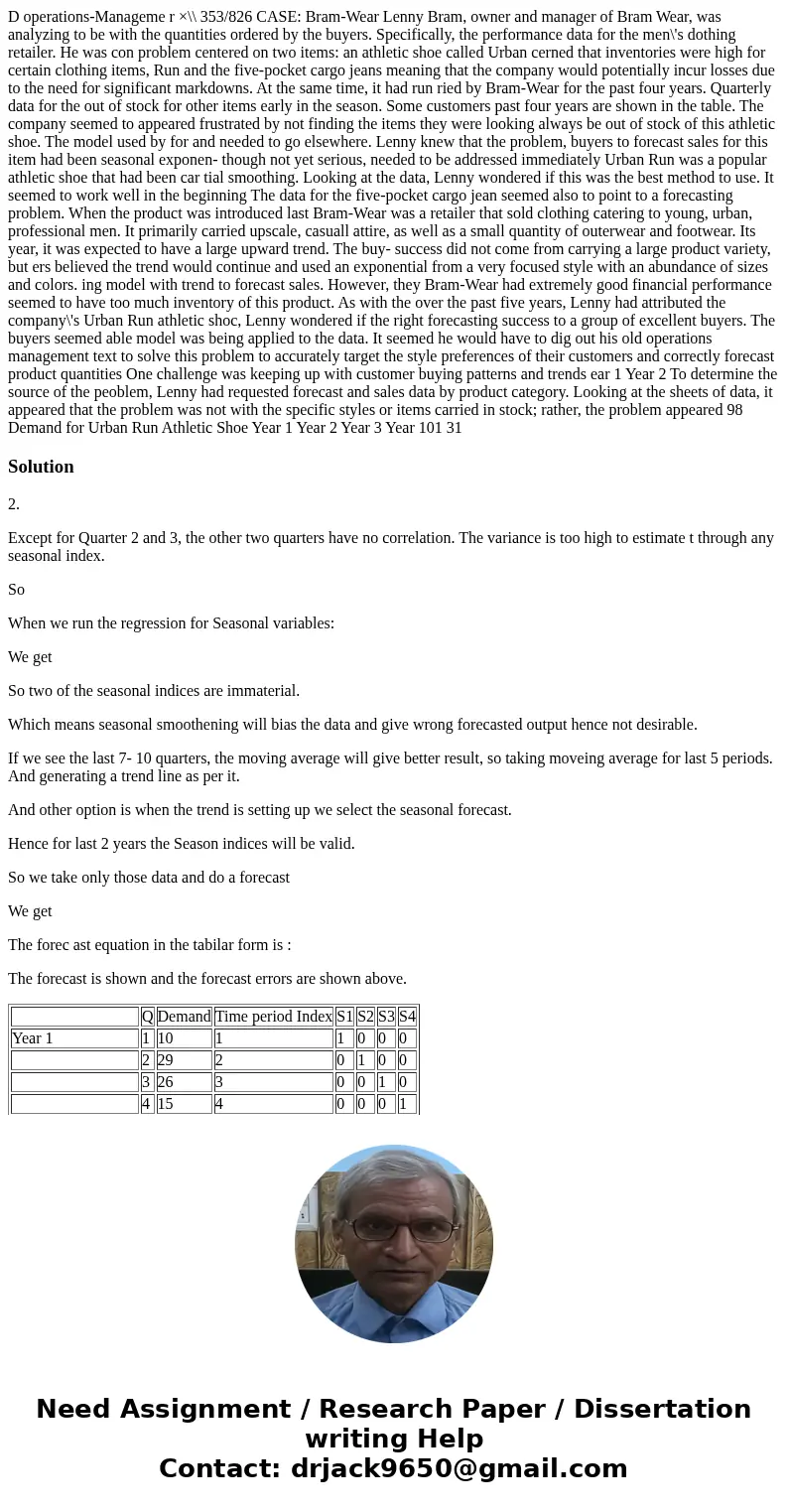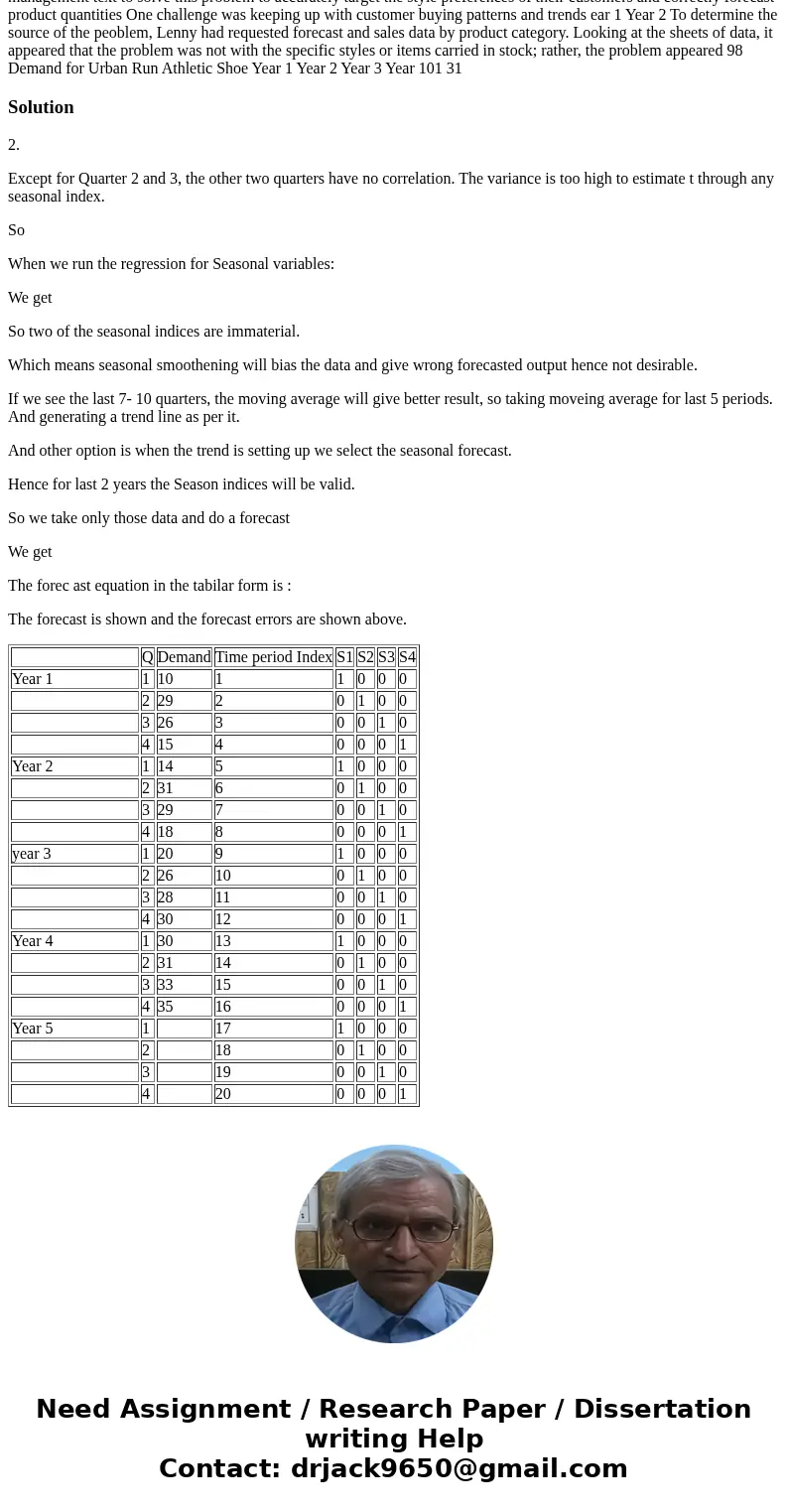D operations-Manageme r ×\\ 353/826 CASE: Bram-Wear Lenny Bram, owner and manager of Bram Wear, was analyzing to be with the quantities ordered by the buyers. Specifically, the performance data for the men\'s dothing retailer. He was con problem centered on two items: an athletic shoe called Urban cerned that inventories were high for certain clothing items, Run and the five-pocket cargo jeans meaning that the company would potentially incur losses due to the need for significant markdowns. At the same time, it had run ried by Bram-Wear for the past four years. Quarterly data for the out of stock for other items early in the season. Some customers past four years are shown in the table. The company seemed to appeared frustrated by not finding the items they were looking always be out of stock of this athletic shoe. The model used by for and needed to go elsewhere. Lenny knew that the problem, buyers to forecast sales for this item had been seasonal exponen- though not yet serious, needed to be addressed immediately Urban Run was a popular athletic shoe that had been car tial smoothing. Looking at the data, Lenny wondered if this was the best method to use. It seemed to work well in the beginning The data for the five-pocket cargo jean seemed also to point to a forecasting problem. When the product was introduced last Bram-Wear was a retailer that sold clothing catering to young, urban, professional men. It primarily carried upscale, casuall attire, as well as a small quantity of outerwear and footwear. Its year, it was expected to have a large upward trend. The buy- success did not come from carrying a large product variety, but ers believed the trend would continue and used an exponential from a very focused style with an abundance of sizes and colors. ing model with trend to forecast sales. However, they Bram-Wear had extremely good financial performance seemed to have too much inventory of this product. As with the over the past five years, Lenny had attributed the company\'s Urban Run athletic shoc, Lenny wondered if the right forecasting success to a group of excellent buyers. The buyers seemed able model was being applied to the data. It seemed he would have to dig out his old operations management text to solve this problem to accurately target the style preferences of their customers and correctly forecast product quantities One challenge was keeping up with customer buying patterns and trends ear 1 Year 2 To determine the source of the peoblem, Lenny had requested forecast and sales data by product category. Looking at the sheets of data, it appeared that the problem was not with the specific styles or items carried in stock; rather, the problem appeared 98 Demand for Urban Run Athletic Shoe Year 1 Year 2 Year 3 Year 101 31
2.
Except for Quarter 2 and 3, the other two quarters have no correlation. The variance is too high to estimate t through any seasonal index.
So
When we run the regression for Seasonal variables:
We get
So two of the seasonal indices are immaterial.
Which means seasonal smoothening will bias the data and give wrong forecasted output hence not desirable.
If we see the last 7- 10 quarters, the moving average will give better result, so taking moveing average for last 5 periods. And generating a trend line as per it.
And other option is when the trend is setting up we select the seasonal forecast.
Hence for last 2 years the Season indices will be valid.
So we take only those data and do a forecast
We get
The forec ast equation in the tabilar form is :
The forecast is shown and the forecast errors are shown above.
| Q | Demand | Time period Index | S1 | S2 | S3 | S4 |
| Year 1 | 1 | 10 | 1 | 1 | 0 | 0 | 0 |
| 2 | 29 | 2 | 0 | 1 | 0 | 0 |
| 3 | 26 | 3 | 0 | 0 | 1 | 0 |
| 4 | 15 | 4 | 0 | 0 | 0 | 1 |
| Year 2 | 1 | 14 | 5 | 1 | 0 | 0 | 0 |
| 2 | 31 | 6 | 0 | 1 | 0 | 0 |
| 3 | 29 | 7 | 0 | 0 | 1 | 0 |
| 4 | 18 | 8 | 0 | 0 | 0 | 1 |
| year 3 | 1 | 20 | 9 | 1 | 0 | 0 | 0 |
| 2 | 26 | 10 | 0 | 1 | 0 | 0 |
| 3 | 28 | 11 | 0 | 0 | 1 | 0 |
| 4 | 30 | 12 | 0 | 0 | 0 | 1 |
| Year 4 | 1 | 30 | 13 | 1 | 0 | 0 | 0 |
| 2 | 31 | 14 | 0 | 1 | 0 | 0 |
| 3 | 33 | 15 | 0 | 0 | 1 | 0 |
| 4 | 35 | 16 | 0 | 0 | 0 | 1 |
| Year 5 | 1 | | 17 | 1 | 0 | 0 | 0 |
| 2 | | 18 | 0 | 1 | 0 | 0 |
| 3 | | 19 | 0 | 0 | 1 | 0 |
| 4 | | 20 | 0 | 0 | 0 | 1 |


 Homework Sourse
Homework Sourse